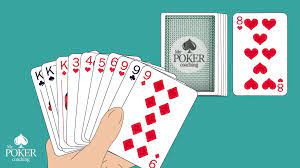Back when the Internet was unheard of, you probably wonder what people were doing to while away the time. Well, aside from baseball, folks play card games, one of which is Gin Rummy. As you probably notice, the name of the card game says something about yet another favorite pastime, drinking. The card game for two was invented by Elwood T. Baker in 1909 and became popular since then. While you might think it’s an ancient game, it is actually a later comer that tried to compete with even more popular games such as Cribbage and Pinoche; both of which were games that go way back as early as 400 years ago. Gin Rummy is closely linked to a genre of card game known as Rummy, where the method that is being used is the “draw and discard”. This means that at every turn, you draw a card from the pile and discard the unwanted card in exchange. The idea is to form sets of matching cards. The match can be 3 or 4 cards of the same rank or same suit in sequence. With such easy to understand rules, it’s no wonder that the game had a loyal following; and it even garnered notoriety for being such an addictive game.
Following the general rules of Rummy, Gin Rummy version is as easy as pie. It starts with each player receiving 10 cards. The standard deck of 52 cards is ranked as follows: Ace, 2, 3, 4, 5, 6, 7, 8, 9, Jack, Queen, and King. Each of the cards has corresponding values. The face cards are given 10 points each and the Ace is given 1 point. Other cards are worth their index value. The 21st card is turned face up to start the discard pile and the rest will be faced down which constitute the stockpile. The object of the game is to collect a hand that can be combined into sets of 3 or more cards having the same suit in consecutive order; or they can be sequences of cards having the same suit in any particular order. The unmatched card (or deadwood) you have should be discarded, and those that remain in your hand should have low point values.
In Gin Rummy, every player’s turn is to “draw a card”. If you draw a card from the stockpile, you are required to discard one card in your hand, unless the stockpile is full, in which case you may draw a card. You can draw a card even if you are already holding a card in your hand. If you are not capable to draw a card, you will have to discard one card in your hand, face down, and expose the card at the center. The value of your hand is the sum of the cards you hold in your hand and the cards exposed in your hand. Your turn is over when you either declare an “end” or “Start” or if the Card sequence or Stack goes over 21.
To declare an “mega88” you have to move all the cards in your hand (those that are not in any of the valid Sets) to the discard pile, and expose all your cards. The player can declare a “start” by exposing all his cards and then moving them to the discard pile. This is to replace those cards in the hand that can not be used. The player will have to mark his Wager once he has completed his turn. The player then exposes all his cards face up to begin his Draw phase. The phase is over when the player exposes all his cards, a valid set or a valid range, and the player’s turn is over. The player can go “Bust” by not having any valid sets and then declare an “end” before declare an “end” or “Start”. The player will be declared the winner for his hand, the opponent by the opponent.
To go “Bust” the player needs to expose all his cards. During the “Draw phase” the player can add cards to the hand. The added cards do not belong to the player but form a valid range, and can be used to form a valid hand. If the player can not draw anymore cards, the hand is removed. The player is then dealt new cards from the top of the deck.
During the “Draw phase” the player can look at his newly drawn cards to see if he can improve them into a valid hand. The player can add cards, remove cards, or transfer cards back to the deck. The cards should be reshuffled to form a new hand. During the “Pre-draw phase” the player deals one card to each player.
During the “Deal phase” the player deals two cards to each player. The cards are then turned face up to start the discard pile. The cards in the hand are then turned face up to start the discard pile. The final hand is played.
